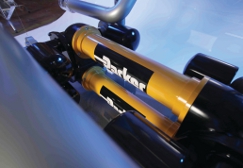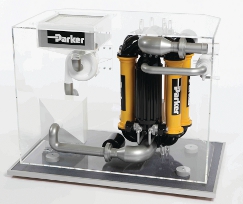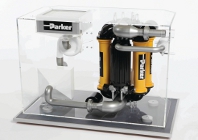Established in 1963, Parker domnick hunter is the world-leading manufacturer of filtration and cold sterilisation systems for compressed air and gases. This position has been achieved by the pursuit of excellence throughout its operation – technological innovation and export achievement have been recognised by eight Queen’s Awards to Industry. Working closely with defence organisations, Parker domnick hunter research and development specialists ensure that every military product is developed fully for its intended use.

The models produced for Parker domnick hunter combine old school model making and the latest prototyping technologies
Since its acquisition by Parker Hannifin in 2005, Parker domnick hunter has continued development of its filtration technologies under the Parker umbrella.
It had previously produced a unique regenerative filtration system designed to protect personnel from chemical and biological (CW and BW) agents, plus other toxic materials developed from one of the company’s core technologies, the pressure swing adsorption system. Parker domnick hunter’s multi adsorbent system provides effective broad spectrum protection from CW and BW agents.
Providing protection
Regenerative CBRN technology uses two identical beds of filter media: an on-line bed of adsorbent material to provide protection, while an off-line bed desorbs previously adsorbed chemicals and a purge system dispels them safely back into the externally contaminated environment.
Although the system is still at a development stage, Parker domnick hunter was keen to demonstrate the technology and evaluate the reaction from interested parties
The beds reverse operation on a predetermined cycle, and it is this ability to regenerate which maintains the safe integrity of the filter to provide continuous protection and safe breathing conditions for various NBC requirement platforms (vehicle, fixed building and shelter).
Parker domnick hunter’s innovative development of the regenerative filter concept culminated in the integration of a pressure and temperature swing (PTSA) system onto BAE Systems’ ETS program. The Trojan and Titan armoured vehicles, based on the Challenger II hull, are the world’s first platforms to have a regenerative CBRN filter system.
The capability of a fully regenerative CBRN filtration system has been successfully demonstrated over the past ten years, and the benefits of Parker domnick hunters’ regenerative CBRN filtration are well known:
Meets protection requirements for from all known CW agents and Toxic Industrial Chemicals (TICs)
Regenerative – hence offers continuous protection
Eliminates logistical support issues
Environmental benefits – no disposal of filters.
The next generation
The next generation of this technology is currently under development and a new media is on trial. The molecular sieve hollow fibre is a semi-porous capillary like tube of adsorbent/polymer mix which is spun to form multi-layer fibres with different compositions of material in each layer.
The filters manufactured with the fibres will show significantly increased adsorbent capacity and improved adsorbent kinetics. These will lead directly to a significant reduction in filter bed size/weight and power requirement. In order to house this lightweight technology, new lighter materials will be required, and concepts are under development to introduce plastic housings and components as opposed to the traditional pressed and cast metal systems.
Model making
Although the system is still at a developmental stage, Parker domnick hunter was keen to demonstrate the technology and evaluate the reaction from interested parties, so the decision was made to prepare two full-size static demonstration models to exhibit at the Eurosatory International Defence Exhibition in Paris and The Farnborough Air Show.
Paragon Rapid Technologies was already a supplier of Rapid Prototyping to Parker domnick hunter and the Parker group, and with its traditional model making skills, paired with extensive stereolithography and vacuum casting capabilities, was an obvious partner to produce the high profile concept models.
As the product was still conceptual, the design did not reflect production processes. Paragon worked alongside Parker domnick hunter from an early stage, advising on processes and solutions for manufacture and assembly.

The models were well received at the exhibitions, and made it possible for the Parker engineers to explain how the concept will work
Concepts were developed for two versions, a linear design and a rotary configuration. The system essentially consists of a series of Filter Cartridges, assembled into manifolds, with pipe work to connect to the ancillary pumps, valves and Hepa filters. All of this is fitted into a box as an enclosed unit.
As the models were required for display and exhibition, a clear protective case was required. The case was fabricated from 8mm clear acrylic to the design of the production enclosure, to serve the dual purpose of protecting the internal components while being representative of the final unit, including all inlets and outlets.
Paragon has a broad range of skills and experience covering the regular RP processes as well as fabrication and machining, and almost all of these processes were implemented to provide the most cost effective solution for the overall project.
The manifolds and more complex components were produced in epoxy resin as stereolithography models on Paragon’s SLA5000. Each part was meticulously finished by hand with a polished gloss finish. Details such as nuts and bolts were added afterward to achieve the production look.
The filter elements were built from scratch using traditional model making techniques with a painted finish. Custom graphics were produced of the Parker logo and applied prior to lacquering.
Wherever ‘multiple’ components were required, Paragon created a master pattern, again through stereolithography, before producing silicone tooling and polyurethane vacuum castings. Many of the parts such as the manifold elbows, butterfly valves and pipe elbows were common to both assemblies and all produced through vacuum casting.
The majority of the pipe work was fabricated from stock tubing, with unique parts such as ‘T’ pieces and ‘S’ bends produced as SL. All of the piping was fully assembled and painted to represent a brushed stainless steel finish.
Although Paragon is at the forefront of prototyping technologies, it was very refreshing to have the need to call upon the more traditional skills of our model makers, and to combine that with our regular process
A standard Hepa filter supplied by Parker domnick hunter was mounted in the top of each unit and this was enclosed within a fabricated acrylic cover carefully thermo formed and bonded, offering full visibility. The heat exchange units were also fabricated from scratch, but with white painted finish. The final models were delivered on time.
“Although Paragon is at the forefront of prototyping technologies, it was very refreshing to have the need to call upon the more traditional skills of our model makers, and to combine that with our regular processes,” says Paragon business development manager Darren Webb. “The whole project was very fluid, with design changes and additional components added at various stages as we were building. We were very happy with the end result and certainly look forward to producing further exhibition models.”
The overall effect is dramatic. The models were well received at the exhibitions, and made it possible for the Parker engineers to explain how the concept will work. Such was the interest at the exhibitions that Parker domnick hunter is now developing the concept for manufacture, for the intended vehicle applications as well as for use with fixed building and shelter applications
www.paragon-rt.com

Old school model making mixed with prototyping techniques helped bring the CBRN filtration system to market






